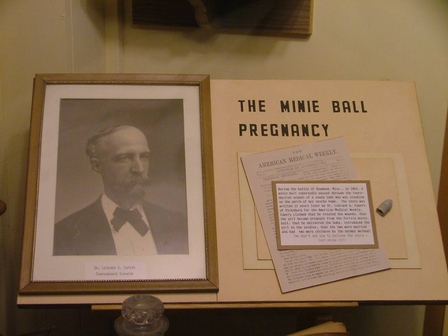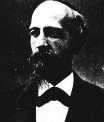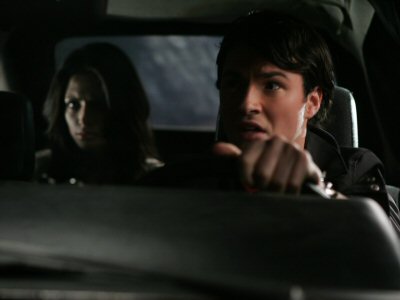
Lurking in the dark waters
of Long Island Sound is a mysterious place known as Plum Island. Just
ten miles off the coast of Connecticut, this tiny speck of land has long
been rumored to be the epicenter of top-secret biowarfare research. The
U.S. government acknowledges that the island is home to a scientific facility. Its stated purpose is to study animal-borne diseases.
But investigators are beginning to uncover startling new facts about
this forbidding place. Insiders and ex-employees have come forward to
tell their stories. From security breaches in germ labs, to escaped diseases and potential mass epidemics, this is the real Plum Island story. But the government denies anything is wrong.
Plum Island's Secret Past
Although the origins of Plum Island are shrouded in secrecy,
investigations have revealed the startling fact that, in the 1950s, the
lab was run by a German scientist named Erich Traub, who was brought to
America after the Second World War. His specialty in the Third Reich was
virus and vaccine research.
Along with rocket scientists like Werner von Braun, Traub was spirited
out of post-war Germany to help jump-start the Cold War against the
Soviet Union. The well-documented U.S. government project to recruit German scientists and technicians was known as Operation Paperclip. President Truman approved the project, so long as only nominal Nazi party members without SS affiliation were recruited. However, because the Nazi party
promoted so many of its top scientists, Operation Paperclip ended up
white-washing the pasts of many of its recruits in order to get them
into the U.S.
Traub's particular expertise was in disease-carrying insects—in
particular, the common tick. Ticks are often carried aloft by birds, and
can therefore quickly spread
over large swaths of territory. Called "vectors," ticks and mosquitoes
are also genetically similar. Both contain bacteriophages or plasmids
that transfer genetic material into a cell, or from one bacterium to
another. In other words, they can infect whatever host animal with which
they come in contact. Multiply this by millions, and ticks become the
perfect insect army.
The Government's Secret Lab 257 - The Horrific Secrets of Plum Island

The
Lost Dutchman Gold Mine (also known by many similar names) is,
according to legend, a very rich gold mine hidden in the southwestern
United States. The location is generally believed to be in the
Superstition Mountains, near Apache Junction, east of Phoenix, Arizona.
There are also theories that the mine lies a considerable distance
beyond the Superstition Mountains, in Mexico. There have been many
opinions about how to find it, and each year people search for it. Some
have died on the search.
The mine is named for German immigrant Jacob Waltz, who purportedly
discovered it in the 19th century and kept its location a secret.
("Dutchman" was a common, though inaccurate, American slang term for
"German," derived from the German word for "German" – "Deutsch").
The Superstition Mountains to the east of Phoenix, AZ reportedly hold a
legendary motherlode of gold known as the Lost Dutchman Gold Mine. Truth
and fiction about this mine have been unrevokably mixed up through the
years, producing 62 varieties of the legend. But before we get into
those, here are some genuine facts about the Lost Dutchman Gold Mine:
There really was a Lost Dutchman, although he wasn’t Dutch. Jakob
Waltz was nicknamed Dutch (i.e. from the Netherlands) because he was
Deutsch (i.e. from Germany; a common error, see also ‘Pennsylvania
Dutch’). A man of that name was born in Württemberg in 1810 and
emigrated to the US. From the 1860s onward, he homesteaded in Arizona,
pursuing mining and prospecting as a hobby – a quite unsuccessful one.
Waltz fell ill and died in 1891, but not before revealing the location
of an alleged gold mine to Julia Thomas, the neighbour who cared for
him. As early as Sept 1, 1892, a local newspaper relates how Thomas and
others were trying to locate the mine. When they failed, it is reported
they sold copies of a map for $7 each. After about a decade, the story
sank into obscurity, regaining notoriety when it had acquired more
spectacular aspects, in a fashion not dissimular to a game of Chinese
whispers.
The Lost Dutchman Gold Mine

In Brazil during the 1950's worldwide "UFO Flap" comes a report of one of the most bizarre accounts on record—the seduction of Antonio Villas Boas.
At the time of his alleged abduction, Antônio Vilas-Boas was a
23-year-old Brazilian farmer who was working at night to avoid the hot
temperatures of the day. On October 16, 1957, he was ploughing fields
near São Francisco de Sales when he saw what he described as a "red
star" in the night sky. According to his story, this "star" approached
his position, growing in size until it became recognizable as a roughly
circular or egg-shaped aerial craft, with a red light at its front and a
rotating cupola on top. The craft began descending to land in the
field, extending three "legs" as it did so. At that point, Boas decided
to run from the scene.
According to Boas, he first attempted to leave the scene on his tractor,
but when its lights and engine died after traveling only a short
distance, he decided to continue on foot. However, he was seized by a
1.5 m (five-foot) tall humanoid, who was wearing grey coveralls and a
helmet. Its eyes were small and blue, and instead of speech it made
noises like barks or yelps. Three similar beings then joined the first
in subduing Boas, and they dragged him inside their craft. Antonio
Villas Boas is located in Brazil
Once inside the craft, Boas said that he was stripped of his clothes and
covered from head-to-toe with a strange gel. He was then led into a
large semicircular room, through a doorway that had strange red symbols
written over it. (Boas claimed that he was able to memorize these
symbols and later reproduced them for investigators.) In this room the
beings took samples of Boas' blood from his chin. After this he was then
taken to a third room and left alone for around half an hour. During
this time, some kind of gas was pumped into the room, which made Boas
become violently ill.
Shortly after this, Boas claimed that he was joined in the room by
another humanoid. This one, however, was female, very attractive, and
naked. She was the same height as the other beings he had encountered,
with a small, pointed chin and large, blue catlike eyes. The hair on her
head was long and white (somewhat like platinum blonde) but her underarm and pubic hair were bright red. Boas said he was strongly attracted to the woman,
and the two had sexual intercourse. During this act, Boas noted that
the female did not kiss him but instead nipped him on the chin.
Famous Alien Abduction of Antonio Villas Boas: Alien Female Seduction

The
Victorio Peak Treasure is one of the most famous treasures in the
United States, second only perhaps to the Lost Dutchman Mine. In
November 1937, a deer hunter and former medicine showman known as Doc
Noss went searching for fresh water near the peak and discovered the
hidden entrance to a tunnel. An old ladder lead into a maze of tunnels
around a large cavern containing an old chest inscribed with the words
"Sealed Silver" in Old English.
Doc Noss was born in Oklahoma and traveled all over the Southwest
seeking excitement. In 1933, he married Ova "Babe” Beckworth and the two
settled down in Hot Springs, New Mexico, which later changed its name
to Truth or Consequences. In November 1937, Doc, Babe, and four others
left on a deer hunt into the Hembrillo Basin. Setting up camp on the
desert floor at the base of Victoria Peak, the men headed into the
wilderness, while their wives stayed at camp. Hunting by himself, Doc
scouted the base of the mountain. When it began to rain, Doc sought
shelter under a rocky overhang near the summit of the mountain. While
waiting for the rain to subside he noticed a stone that looked as if it
had been "worked” in some fashion. Reaching down, he was unable to budge
it, but after digging around the rock, he got his hands under it.
Lifting the rock, he found a hole that lead straight down into the
mountain.
November 1937, Doc, Babe, and four others left on a deer hunt into the
Hembrillo Basin. Setting up camp on the desert floor at the base of
Victorio Peak, the men headed into the wilderness, while their wives
stayed at camp. Hunting by himself, Doc scouted the base of the
mountain. When it began to rain, Doc sought shelter under a rocky
overhang near the summit of the mountain. While waiting for the rain to
subside he noticed a stone that looked as if it had been “worked” in
some fashion. Reaching down, he was unable to budge it, but after
digging around the rock, he got his hands under it. Lifting the rock,
he found a hole that lead straight down into the mountain.
Peering into the darkness, Doc saw an old man-made shaft with a thick,
wooden pole attached at one side. Doc thought that he had discovered an
old abandoned mineshaft. When the rain finally stopped, Doc returned to
camp, telling Babe of the discovery. The two decided to keep the
discovery between themselves and return to the inspect the shaft later.
The Search for Gold at Victorio Peak

In
November 1874 an unusual article appeared in the introductory volume of
The American Medical Weekly, a Louisville medical journal. It was
written by Dr. LeGrand G. Capers and was titled, "Attention
Gynaecologists!—Notes from the Diary of a Field and Hospital Surgeon,
C.S.A." In the article Dr. Capers recounted an unusual case of
artificial insemination he had witnessed on a Civil War battlefield in
Mississippi, in which a bullet had passed through a soldier's testicles,
and then traveled on before hitting a woman and impregnating
her. The event was said to have occurred on May 12, 1863 at around 3
p.m. at the "battle of R." (battle of Raymond), where "Gen. G's brigade"
(Brigadier General John Gregg) of the Confederate forces fought Grant's
army led by "Gen. L." (Major General John A. Logan).

In 1874, The American Medical Weekly ran an article by a Dr. LeGrand
Capers (that's him in the picture) who claimed he witnessed this very
thing on a Civil War battlefield. Apparently there was a house very
close to the Confederate lines, and a bullet (a "minnie ball") hit a
soldier, "carrying away the left testicle", and then continued
its course toward the house. One of the daughters in the house had also
been hit by a stray bullet, which was lost in the abdominal cavity
somewhere.
Because the doctor was stationed with the army nearby, he continued to
check on the wounded girl over the next several months. Around the
six-month mark, he discovered that the girl was pregnant. Around the nine-month mark, she gave birth to a nine-pound baby boy.
The family was beyond embarrassed that their unmarried daughter was apparently having "indiscretions",
but the girl swore that she was a virgin. The doctor examined her and
said it was true - she had never had sex. Meanwhile, the little boy was
very sick and he had some incredible swelling in the groin area. The
doctor decided to operate, and when he did, he pulled out a minnie ball.
He put two and two together and figured out that the bullet must have picked up some semen
went it ripped through the soldier's testicle, and managed to
impregnate the girl when it lodged inside of her stomach. Supposedly,
the girl and the soldier ended up getting married and having two more
kids.
The problem? The doctor had invented the whole story in order to mock
the ridiculous stories that were coming out of the battlefield. But it
was taken as fact, and was even reprinted in 1959 in the New York State
Journal of Medicine.
Son of a gun : Case of the Miraculous Bullet

The
vanishing hitchhiker (the ghostly hitchhiker, the disappearing
hitchhiker, the phantom hitchhiker or the hitchhiker) story is an urban
legend in which people traveling by vehicle meet with or are accompanied
by a hitchhiker who subsequently vanishes without explanation, often
from a moving vehicle. Vanishing hitchhikers have been reported for
centuries and the story is found across the world, with many variants.
The popularity and endurance of the legend has helped it spread into
contemporary popular culture.
ONE OF THE most persistent and entertaining types of ghost stories is
that of the phantom or vanishing hitchhiker. It's also one of the most
chilling because, if true,it brings ghosts in very close contact with
mortals. More disconcerting still, the stories depict the specters as
looking, acting, and sounding like living people - even physically
interacting with the unsuspecting drivers who pick them up.
The archetypal modern vanishing hitchhiker is a figure seen in the
headlights of a car traveling by night with a single occupant. The
figure adopts the stance of a hitchhiker. The motorist stops and offers
the figure a lift. The journey proceeds, sometimes in total silence, and
at some subsequent point, the passenger appears to vanish while the
vehicle is in motion. In many cases, the hitchhiker vanishes when a
(normally red) vehicle reaches the hitchhiker's destination. The basic
story usually goes something like this: a weary driver traveling at
night picks up a strange hitchhiker, drops him or her off at some
destination, then somehow later finds out that the hitchhiker had in
fact died months or years earlier - often on that very same date. Like
many "true" ghost stories, tales of phantom hitchhikers are difficult to
verify, and are most often relegated to the category of urban legend or
folklore. But there are many such stories, and it's up to you whether
or not you believe any of them. Here are a few:
Red-Headed Hitchhiker of Route 44
There's a classic urban legend called the Phantom Hitchhiker, which goes something like this.
One night, a man's driving down a dark country road when he notices a
young lady hitchhiking by the side of the road. She's pretty, with long
blonde hair, and she's wearing a blue dress. The man thinks, "She looks
safe. Why not pick her up?" The young lady gets in the passenger seat
and says "There's a big white farm house about a mile down the road.
Could you drop me off there?"
Phantom Hitchhikers : The Vanishing hitchhiker Ghost Stories







